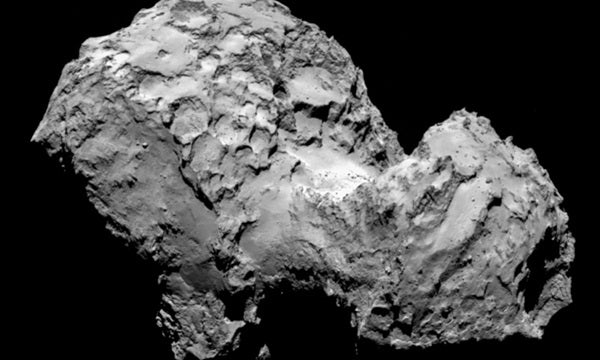In fact, this may be a repeating process fundamental to comet evolution, according to the study.
The team, led by Masatoshi Hirabayashi from Purdue and Daniel Scheeres from CU-Boulder, studied several comets, primarily a bizarre rubber duck-shaped object known as 67P/Churyumov-Gerasimenko (67P). Images of 67P show two cracks, each longer than an American football field, on the comet’s neck that connects its two larger lobes.
In order to reconstruct the past life of 67P, the team used numerical models in which the spin rate was cranked up from its roughly one rotation every 12 hours today to one rotation every seven to nine hours. The models showed the faster spin would lead to more stress and the formation of two similar cracks on the neck of 67P in the same location.
“Our spin analysis predicted exactly where these cracks would form,” said Scheeres. “We now have a new understanding of how some comets may evolve over time.”
Often referred to as “dirty snowballs,” comets are made of ice, rocks, and dust. Comet 67P is “bilobed,” meaning it has two larger parts connected by a thinner neck.
Scheeres said there are several factors that can cause comet nuclei to spin faster. During flybys of the Sun or Jupiter, for example, periodic comets like 67P can get torqued by gravity, causing them to either spin up or spin down. The spin also can be affected by periodic comet “outgassing,” when icy compounds like carbon dioxide and ammonia shift directly from a frozen state to gaseous state and blow off the surface.
The models run by the team showed that if 67P’s spin is increased to less than seven hours per rotation, the head will pop off, said Scheeres. So what happens then?
“The head and body aren’t going to be able to escape from each other,” he said. “They will begin orbiting each other, and in weeks, days or even hours they will come together again during a slow collision, creating a new comet nucleus configuration.”
This pattern could go on for the life of the comet, said Scheeres.
Bilobed comets may turn out to be fairly common. Of the seven comets that have been imaged in high resolution by astronomers, five of those , including P67 and Comet Halley, are bilobed, said Scheeres. Studies of the bilobed comets by the team indicate they all are similar in their volume ratios between each lobe, meaning they probably go through the same break-up/make-up cycles as 67P.
Discovered in 1969 and visited by the European Space Agency’s Rosetta spacecraft in 2014, 67P is roughly 2.5 miles on a side and orbits the Sun every 6.5 years. The team showed that the comet’s spin rate can change chaotically, driven by outgassing events and its changing orbit driven by flybys of Jupiter.
To show how this comet-Sun interaction affected the past evolution of 67P’s spin period, the researchers numerically modeled 1,000 comet “clones” of 67P under varying conditions going back 5,000 years. Five thousand years was selected because it is the approximate lifetime of a “Jupiter family comet” like 67P, whose orbit is affected by the gravity of not only the Sun but the gas giant Jupiter, the largest planet in our solar system, said Scheeres.
Periodic comets like 67P are thought to originate in the Kuiper Belt, a vast region beyond Neptune’s orbit harboring billions of comets and icy moons. The team hypothesized that the repeated break-up and make-up of bilobed comets may have caused them to erode too much to have survived their journeys into the inner solar system 4 billion years ago when it was a shooting gallery of asteroids, moons, and protoplanets.










